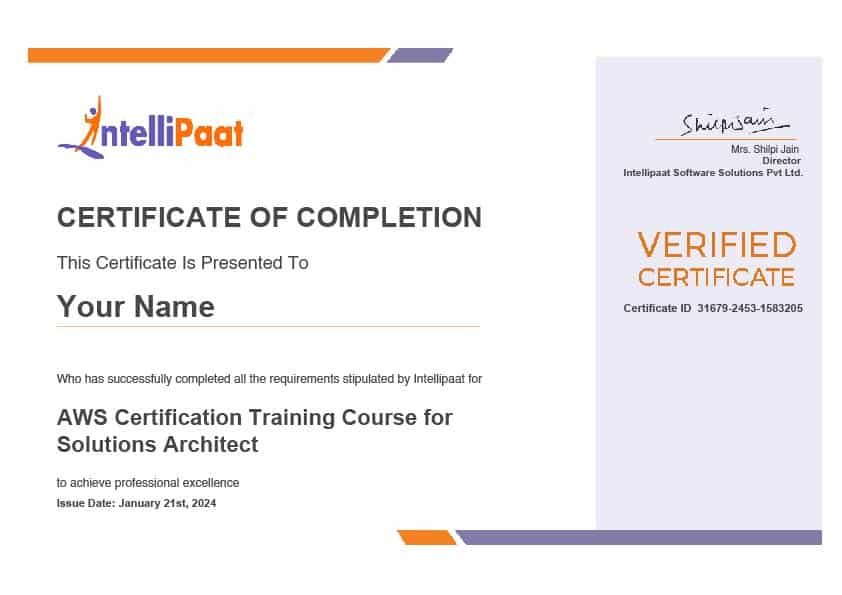Your cart is currently empty.
 Courses
Courses
 Courses
Courses
AWS training in Delhi for the AWS Certified Solutions Architect exam. Learn AWS concepts like CloudTrail, Redshift, EC2, Lambda, and S3 through hands-on projects and case studies from AWS-certified mentors.

Watch
Course PreviewRead More
Basic knowledge of any programming language will be an added advantage for taking up this Amazon Web Services training in Delhi.
This AWS training can be signed up by professionals such as:
The national capital region of India including nearby satellite cities offer exclusive opportunities for professionals in the AWS domain. There are a huge number of Indian and multinational corporations that call Delhi their home, and most of them are deploying AWS technologies at scale making it worthwhile for professionals to pursue a career in AWS, thanks to lucrative job opportunities in New Delhi and surrounding areas. By obtaining an AWS certification in Delhi, you can boost your chances of getting hired.
In Delhi, AWS Certification costs Rs. 10,700. In addition, the AWS Solutions Architect Associate test lasts 130 minutes.
In India, there are about 427 new AWS job opportunities available, as per Glassdoor.
Getting ahead in your career is tough today if you don’t have expertise in trending technologies. AWS is one such trending technology that has a huge upside, making it very beneficial to master this technology. Intellipaat offers industry-leading AWS training in Delhi with placement to help you land your dream job.
Talk To Us
We are happy to help you 24/7
59% Average Salary Hike
$1,08,000 Highest Salary
700+ Career Transitions
300+ Hiring Partners
Career Transition Handbook
*Past record is no guarantee of future job prospects
Who should take this AWS Course in Delhi?
AWS EC2 and Elastic Beanstalk
Amazon S3
AWS Lambda
AWS RDS and DynamoDB
CloudWatch and IAM
EBS, EFS, and FSx
ELB, Auto Scaling
Global Accelerator
CloudFormation
OpsWorks
AWS Global Infrastructure
AWS Well-Architected Framework
AWS Command Line Interface
AWS Networking
Auto-scaling
AWS Security Services
AWS Databases
VPC Networking
AWS Logging Mechanisms
AWS Storage Cost Optimization
$1,499
Contact Us
1.1 Understanding Cloud Computing and its Concepts
1.2 Learning Cloud Services and an Overview of Deployment Models
1.3 How is Amazon Web Services leading in the cloud industry?
1.4 Various types of cloud services provided by AWS
1.5 Introduction to AWS fundamental service: IAM, S3, EC2, VPC, EBS, ELB, and AMI
1.6 Understanding the virtualization concept in AWS (Xen hypervisor)
1.7 Exploring the AWS Architecture and the AWS Management Console,
1.8 How does auto-scaling work?
1.9 Best Practices of securing and optimizing costs in AWS Elastic Cloud Computing
Hands-on Exercise
2.1 Getting Started with the AWS Elastic Cloud Computing
2.2 Exploring the Global Infrastructure, AWS Regions, and Highly Availability Zones (AZs)
2.3 Understanding the usage of traditional servers Pre-EC2 and EC2 instance types
2.4 Comparing the difference between the Public IP and Elastic IP
2.5 Demonstrating how to launch an AWS Elastic Cloud Computing with various instance types
2.6 Understanding the Amazon Machine Image, Creating and Copying a Custom AMI
2.7 Introduction to Amazon Elastic Block Storage
2.8 Exploring the EBS Volume Types
2.9 Creating the EBS Snapshots
2.10 Introduction to Amazon Elastic File Storage (EFS)
2.11 What are the Instance tenancy- Reserved and Spot instances
2.12 Exploring the Pricing and Design Patterns.
Hands-on Exercise –
3.1 Getting Started with the Elastic Load Balancer
3.2 Understand the Types of Elastic Load Balancer – Network, Application, and Gateway
3.3 How does the Elastic Load Balancer architecture work?
3.4 Working of Cross-zone Load Balancing
3.5 Understand the concepts of Auto Scaling, vertical and horizontal scaling, and the lifecycle of Auto Scaling
3.6 Understand the components of Auto Scaling, scaling options, and policy, instance termination
3.7 Working with Auto Scaling using the load balancer
3.8 Exploring the work of Domain Name Server and Pre-Route 53
3.9 Understand the concepts: Routing policy, Route 53 terminologies, Pricing
Hands-on Exercise –
4.1 Understanding the Isolated Amazon Virtual Private Cloud?
4.2 Networking layer architecture in VPC for an EC2
4.3 Understanding the concepts of IP address and CIDR notations
4.4 Exploring the various Components of VPC – Network interfaces, route tables, internet gateway, NAT gateway
4.5 Cloud Security in Virtual Private Cloud – Security groups and NACL
4.6 Types of Virtual Private Cloud
4.7 What is a subnet, VPC peering with scenarios,
4.8 Understanding the working of VPC endpoints, VPC pricing, and design patterns
Hands-on Exercise –
5.1 Getting started with the AWS storage and Simple storage service
5.2 Learn a Pre-S3 – cloud storage
5.3 Learn an API, S3 consistency models
5.4 Understand the hierarchy of storage and the usage of buckets in S3
5.5 What are Objects in S3, metadata and storage classes,
5.6 How Object Versioning Works in S3
5.7 Managing the object lifecycle, cross-region replication
5.8 Understanding the storage concepts: Data encryption, connecting using a VPC endpoint, S3 pricing.
Hands-on Exercise –
6.1 Define database, What are the types of databases?
6.2 Exploring the databases services on AWS
6.3 Understand the workings of Amazon Relational Databases Services
6.4 Configuring and launching an Amazon RDS Multi-AZ deployment,
6.5 What are the Features of Amazon Relational Databases Services?
6.6 Understand the concepts of Read replicas in RDS and reserved DB instances
6.7 Overview of RDS pricing and design patterns
6.8 Exploring the Amazon Aurora, benefits of Aurora, pricing of Aurora, and its design patterns
6.9 Introduction to DynamoDB, components of DynamoDB, DynamoDB pricing, and design patterns
6.10 Understand the workings of Amazon Redshift, and list the advantages of Redshift.
6.11 Explore the features and workings of Amazon ElastiCache
Hands-on Exercise –
7.1 Getting Started with the CloudFormation as IaC
7.2 Understand the CloudFormation components
7.3 Working on CloudFormation templates
7.4 Learn the concept of Infrastructure-as-a-code
7.5 Understand the Functions and Pseudo Parameters
7.6 Understanding the Simple Notification Service and the Working of SNS
7.7 Understanding the Simple Email Service and the Working of SES
7.8 Understanding the Simple Queue Service and the Working of SQS
Hands-on Exercise –
8.1 Pre-IAM, why access management
8.2 What is Amazon Resource Name (ARN)? , What are the IAM features?
8.3 Using Multi-factor Authentication (MFA) in IAM, JSON
8.4 Working with the IAM policies, IAM permissions, IAM roles, identity federation, and pricing
8.5 Working with AWS monitoring service CloudWatch,
8.6 Understanding CloudWatch concepts metrics and namespaces, CloudWatch architecture, dashboards in CW, CloudWatch alarms, CloudWatch logs, pricing, and design patterns
8.6 Understanding the work of CloudTrail, tracking API usage.
Hands-on Exercise –
9.1 Getting Started with the AWS Lambda – Serverless Compute
9.2 How does AWS Lambda differ from Elastic Cloud Computing?
9.3 What are the benefits and limitations of AWS Lambda?
9.4 What is the function of AWS Lambda?
9.5 Learn the AWS Lambda concepts and its use cases
9.6 Integrating and managing S3 with AWS Lambda
9.7 Getting Started with the Elastic Beanstalk,
9.8 Working of Elastic Beanstalk,
9.9 Learn the AWS Elastic Beanstalk concepts and Elastic Beanstalk pricing
9.10 Explore Configuration Management?
9.11 How does AWS OpsWorks work? , What are the benefits of AWS OpsWorks?
9.12 Compare the difference between CloudFormation and OpsWorksservices in OpsWorks,
9.13 Understanding the concepts of AWS OpsWorks Stacks and OpsWorks pricing.
Hands-on Exercise –
10.1 Understanding the working of Cloud Migration
10.2 What is the significance of migration?
10.3 Elaborate the Migration strategy in Amazon Web Services,
10.4 Explain the 6 R’s migration strategy
10.5 Learn about migration of Virtual machine, migrating a local VM onto the AWS cloud server
10.6 Understanding the working of Migrating databases using Database Migration Service (DMS)
10.7 How to Migrate a Local Database to Relational Database Service
10.8 Migrating an on-premises database server to a Relational Database Service using Database Migration Service (DMS), and other migration services.
11.1 Essential principles for building a robust and efficient AWS Well-Architected Framework
11.2 Architecting and Designing of fault-Tolerance and high-availability architecture
11.3 Selecting the Appropriate Resilient Storage
11.4 Mechanism for design decoupling using AWS services
11.5 Architecting and Designing a Multi-tier Architecture Solution
11.6 Design and implement Disaster recovery solution
11.7 Architecting and Designing Scalable and Elastic Solutions.
12.1 What is the DevOps methodology?
12.2 Getting Started with AWS DevOps,
12.3 Understanding the working of AWS Developer tools – CodeCommit, CodeBuild, and CodeDeploy
12.4 Understanding the working of AWS Developer tools – CodePipeline, integrating GitHub with CodePipeline
12.5 Designing and implementing a DevOps lifecycle using AWS DevOps tools.
13.1 Understanding the FSx
13.2 What are the Types of FSx? and FSx for Windows server
13.3 Elaborate the working of FSx for Windows File Server
13.4 FSx for Lustre and its Use Cases
13.5 Working of Automatic Failover Process
13.6 Supported clients and access methods
13.7 What is a Global Accelerator?
13.8 How does Global Accelerator work? Listeners and Endpoints
13.9 What are AWS organizations?
13.10 Features of AWS Organizations, Managing Multiple Accounts
13.11 Understand the concepts of ENIs, ENAs, and EFAs. Working with network interfaces
13.12 Work with the upgraded networking with ENA, EFA with MPI, and Monitoring an EFA
Hands-on Exercise:
14.1 Getting Started with Containers and Container Orchestration
14.2 Working with the Amazon Elastic Container Registry (ECR)
14.3 Understanding concepts of Amazon Elastic Container Service ECS
14.4 Understanding concepts of ECS Launch Types and Use Cases
14.5 What is AWS Fargate?
Hands-on Exercise:
15.1 Guidance for clearing the exam, most probable interview questions, and other helpful tips for clearing the exam and interview.
AWS Projects
Practice Essential Tools
Designed By Industry Experts
Get Real-world Experience
This course is designed to clear the AWS Certified Solutions Architect exam. The entire course is in line with the AWS certification curriculum and helps you get the best jobs in top MNCs.
As part of this AWS training, you will be working on real-time projects and assignments that have immense implications in real-world industry scenarios, thus helping you fast-track your career effortlessly.
At the end of this AWS Solutions Architect Associate certification training in Delhi, there will be a quiz that perfectly reflects the type of questions asked in the certification exam and helps you score better.
Intellipaat’s course completion certificate will be awarded upon the completion of the project work (after expert review) and scoring at least 60 percent marks in the quiz. This certification is well-recognized by top 80+ MNCs such as Ericsson, Cisco, Cognizant, Sony, Mu Sigma, Saint-Gobain, Standard Chartered, TCS, Genpact, Hexaware, etc.
Our Alumni Work At
Hear From Our Hiring Partners
Intellipaat’s AWS training gives you hands-on experience working with the top-notch Amazon Web Services platform that is used by some of the biggest corporations in the world. You can master the concepts of AWS cloud infrastructure and software as a service and learn how to design, plan, and scale the AWS platform as per best practices. The entire course content is in line with the requirements for clearing the AWS Certification Solutions Architect exam.
You will be working on real-time AWS projects and step-by-step assignments that have high relevance in the corporate world, and the curriculum is designed by industry experts. Upon completion of the Amazon Web Services course, you can apply for some of the best jobs in top MNCs around the world at top salaries. Intellipaat offers lifetime access to videos, course materials, 24/7 support, and course material upgrading to the latest version at no extra fee. Hence, it is clearly a one-time investment.
Intellipaat has been serving AWS aficionados from all over the city. You can live in any part of Delhi, including Delhi NCR, New Delhi, Saket and other South Delhi areas, Janakpuri, Uttam Nagar, Dwarka, Laxmi Nagar, Preet Vihar, Karol Bagh, Pitampura, Shastri Nagar, Paschim Vihar, Vasant Kunj, Mahipalpur, and others. You can access our AWS training from the comfort of your own home or office.
The numerous other AWS-related cloud training courses offered by Intellipaat in Delhi are AWS DevOps, Blockchain, Azure, Azure DevOps, Azure Developer, GCP and DevOps.
Intellipaat publishes numerous Amazon Web Services blogs weekly. The top free resources available for learners are Tutorial, Interview Questions, and everything about AWS.
Intellipaat offers query resolution, and you can raise a ticket with the dedicated support team at any time. You can avail yourself of email support for all your queries. We can also arrange one-on-one sessions with our support team If your query does not get resolved through email. However, 1:1 session support is given for 6 months from the start date of your course.
Intellipaat provides placement assistance to all learners who have completed the training and moved to the placement pool after clearing the PRT (Placement Readiness Test). More than 500+ top MNCs and startups hire Intellipaat learners. Our alumni work with Google, Microsoft, Amazon, Sony, Ericsson, TCS, Mu Sigma, etc.
Apparently, no. Our job assistance is aimed at helping you land your dream job. It offers a potential opportunity for you to explore various competitive openings in the corporate world and find a well-paid job, matching your profile. The final hiring decision will always be based on your performance in the interview and the requirements of the recruiter.
Delhi, India’s vibrant capital city, stands as a symbol of livability and economic growth. Situated beside the Yamuna River, Delhi accommodates a population exceeding 20 million, connected by the Delhi Metro.
The IT industry has played a key role in Delhi’s economic success, with over 9 lakh IT workers helping to build a strong economy. With a projected growth rate of 10.5%, Delhi is positioned for even greater success in the years to come.
Delhi’s culture and heritage display a mix of Mughal grandeur and British colonial charm. This is seen in landmarks like the Red Fort and Connaught Place. Following are some of the most lively places in Delhi:
















 Click to Zoom
Click to Zoom
